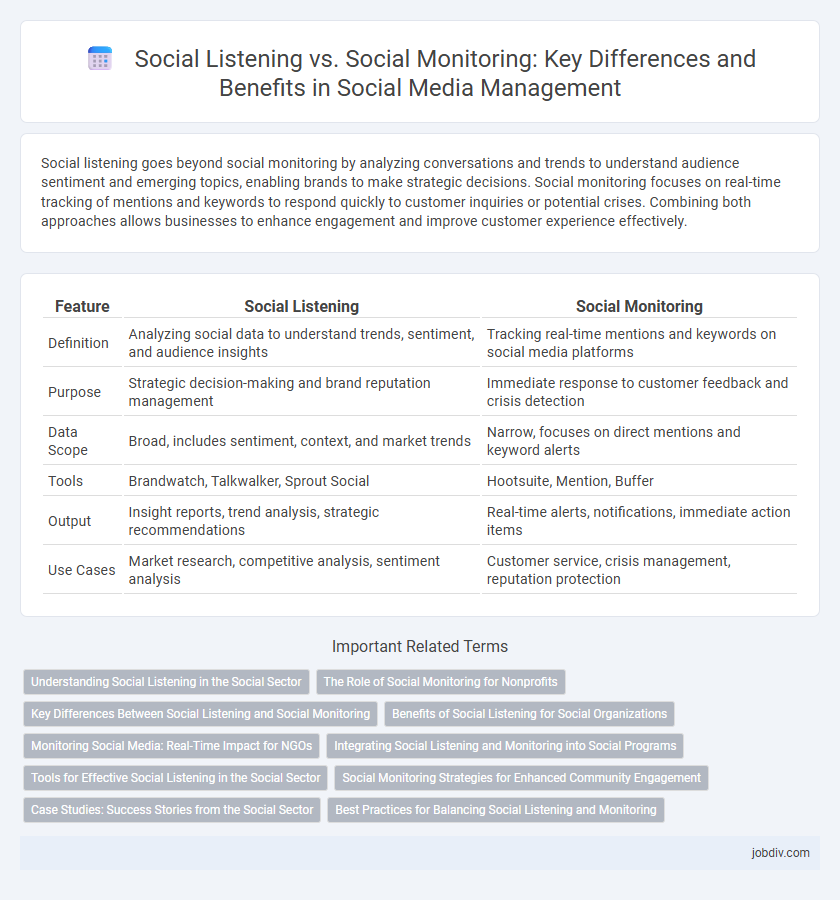Social listening goes beyond social monitoring by analyzing conversations and trends to understand audience sentiment and emerging topics, enabling brands to make strategic decisions. Social monitoring focuses on real-time tracking of mentions and keywords to respond quickly to customer inquiries or potential crises. Combining both approaches allows businesses to enhance engagement and improve customer experience effectively.
Table of Comparison
| Feature | Social Listening | Social Monitoring |
|---|---|---|
| Definition | Analyzing social data to understand trends, sentiment, and audience insights | Tracking real-time mentions and keywords on social media platforms |
| Purpose | Strategic decision-making and brand reputation management | Immediate response to customer feedback and crisis detection |
| Data Scope | Broad, includes sentiment, context, and market trends | Narrow, focuses on direct mentions and keyword alerts |
| Tools | Brandwatch, Talkwalker, Sprout Social | Hootsuite, Mention, Buffer |
| Output | Insight reports, trend analysis, strategic recommendations | Real-time alerts, notifications, immediate action items |
| Use Cases | Market research, competitive analysis, sentiment analysis | Customer service, crisis management, reputation protection |
Understanding Social Listening in the Social Sector
Social listening in the social sector involves analyzing conversations and trends across social media platforms to gain insights into public sentiment, community needs, and emerging issues. Unlike social monitoring, which tracks specific mentions or keywords, social listening interprets the broader context and emotions behind online interactions to inform strategic decision-making and program development. This approach enables organizations to proactively address concerns, engage authentically with stakeholders, and measure the impact of social initiatives.
The Role of Social Monitoring for Nonprofits
Social monitoring plays a crucial role for nonprofits by continuously tracking brand mentions, donor feedback, and campaign performance across social media platforms, enabling timely responses to community needs and enhancing engagement. It helps identify emerging trends and potential issues, allowing nonprofits to adapt strategies and improve outreach effectiveness. By leveraging social monitoring tools, nonprofits can optimize resource allocation, foster stronger relationships with stakeholders, and increase overall impact.
Key Differences Between Social Listening and Social Monitoring
Social monitoring involves tracking specific keywords, brand mentions, and metrics on social media platforms to measure audience engagement and respond to immediate customer queries. Social listening goes deeper by analyzing the broader sentiment, trends, and conversations surrounding a brand or industry to inform strategic decisions and uncover insights. The key difference lies in social monitoring's reactive approach focusing on data collection, while social listening's proactive strategy interprets data for long-term relationship building and market opportunities.
Benefits of Social Listening for Social Organizations
Social listening enables social organizations to gain deep insights into community sentiment, enabling proactive engagement and tailored support strategies. By analyzing conversations across multiple platforms, organizations can identify emerging trends and address concerns promptly, enhancing overall impact and trust. This strategic advantage fosters stronger relationships and drives data-informed decision-making critical for mission success.
Monitoring Social Media: Real-Time Impact for NGOs
Social monitoring provides NGOs with real-time data on audience sentiment, enabling rapid response to emerging issues and enhancing community engagement. By tracking specific keywords, hashtags, and mentions, NGOs can identify trends and crises early, allowing for proactive communication strategies. This immediate insight supports better decision-making and helps NGOs amplify their impact through timely and relevant social media interactions.
Integrating Social Listening and Monitoring into Social Programs
Integrating social listening and social monitoring into social programs enhances real-time understanding of community sentiment and emerging trends, enabling proactive response strategies and data-driven decision-making. By combining qualitative insights from social listening with quantitative metrics from social monitoring, organizations can tailor interventions more effectively and track program impact with greater accuracy. This holistic approach improves stakeholder engagement and fosters adaptive management in dynamic social environments.
Tools for Effective Social Listening in the Social Sector
Social listening tools like Brandwatch, Sprout Social, and Hootsuite enable organizations in the social sector to analyze audience sentiment, track emerging trends, and measure campaign impact by aggregating data from multiple social media platforms. These platforms provide deep semantic analysis and real-time alerts that help nonprofits and advocacy groups engage authentically and adapt strategies based on community feedback. Leveraging these tools allows social sector entities to enhance stakeholder communication and improve program outcomes through data-driven insights.
Social Monitoring Strategies for Enhanced Community Engagement
Social monitoring strategies involve tracking brand mentions, keywords, and user interactions across social media platforms in real-time to gauge community sentiment and respond promptly. Leveraging tools like Hootsuite, Sprout Social, and Brandwatch enables brands to identify trends, address concerns, and personalize engagement to foster loyalty. Consistent monitoring combined with data-driven insights enhances community engagement by aligning responses with audience preferences and behaviors.
Case Studies: Success Stories from the Social Sector
Social listening enables organizations in the social sector to uncover deeper insights by analyzing conversations, sentiment, and trends, leading to more impactful community engagement and program adjustments. Case studies reveal that nonprofits leveraging social listening tools increased donor engagement by up to 40%, while social monitoring primarily helped organizations quickly respond to crises or misinformation. Success stories highlight how social listening contributed to strategic advocacy campaigns, amplified voices of marginalized groups, and improved resource allocation for social causes.
Best Practices for Balancing Social Listening and Monitoring
Effective social media strategies integrate both social listening and social monitoring by leveraging real-time data analysis and sentiment detection tools to capture customer insights and brand perception. Prioritizing context-specific keyword tracking and adjusting response protocols ensures timely engagement without overwhelming resources. Consistently reviewing collected data through analytics platforms supports informed decision-making and enhances overall social media performance.
Social Listening vs Social Monitoring Infographic

 jobdiv.com
jobdiv.com